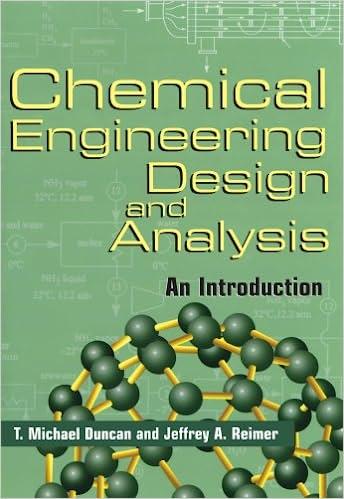Answered step by step
Verified Expert Solution
Question
1 Approved Answer
PLP 1 0 : ( Problem 5 in sample exam ) Due on Feb 7 t h . Most modern processes for production of nitric
PLP : Problem in sample exam Due on Feb
Most modern processes for production of nitric acid are based on the sequential oxidation of ammonia to oxides of nitrogen followed by absorption of these intermediates in water. In the flowsheet shown in Figure ammonia and air are mixed in a : molar ratio and reacted catalytically in the first reactor stage. The two reactions occurring are the main reaction
and the secondary reaction
All of the is converted with a selectivity for In the second reactor stage, the produced is further oxidized to via the reaction
Finally, the reactor effluent is further treated with water to produce the desired product. The scrubber reaction is
The waste gas from the process contains and about The air composition may be taken as and Assuming all compositions are in mol calculate the composition of all streams in the process.
Overall Process
No Unknown Labeled variables
No Independent chemical reactions one extent of reaction for each
No Independent reactive species balances
No Independent nonreactive species
No Known relations
No Degrees of frEedom
Reactor
No Unknown Labeled variables
No Independent chemical reactions one extent of reaction for each
No Independent reactive species balances
No Independent nonreactive species
No Known relations
No Degrees of freedom
Reactor
No Unknown Labeled variables
No Independent chemical reactions one extent of reaction for each
No Independent reactive species balances
No Independent nonreactive species
No Known relations
No Degrees of freedom
PLP : Problem in sample exam Due on Feb
Most modern processes for production of nitric acid are based on the sequential oxidation of ammonia to oxides of nitrogen followed by absorption of these intermediates in water. In the flowsheet shown in Figure ammonia and air are mixed in a : molar ratio and reacted catalytically in the first reactor stage. The two reactions occurring are the main reaction
and the secondary reaction
All of the is converted with a selectivity for NO In the second reactor stage, the produced is further oxidized to via the reaction
Finally, the reactor effluent is further treated with water to produce the desired product. The scrubber reaction is
The waste gas from the process contains and about The air composition may be taken as and Assuming all compositions are in mol calculate the composition of all streams in the process.

Step by Step Solution
There are 3 Steps involved in it
Step: 1

Get Instant Access to Expert-Tailored Solutions
See step-by-step solutions with expert insights and AI powered tools for academic success
Step: 2

Step: 3

Ace Your Homework with AI
Get the answers you need in no time with our AI-driven, step-by-step assistance
Get Started


